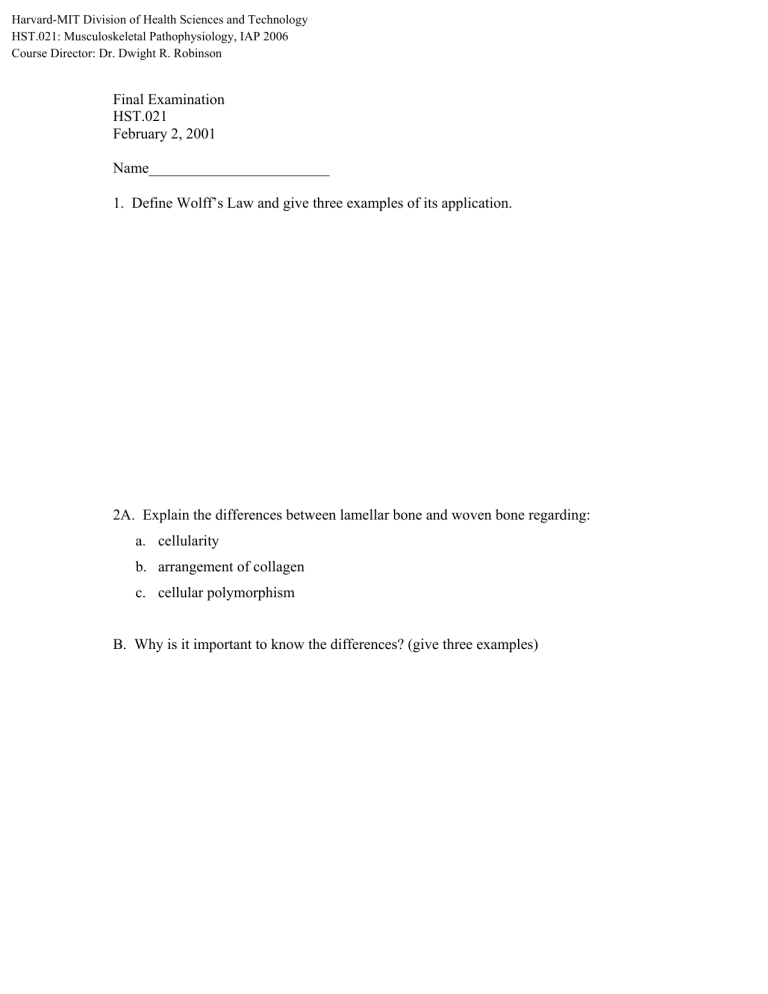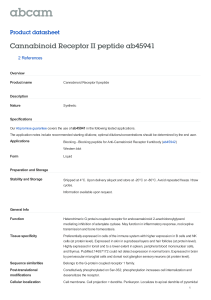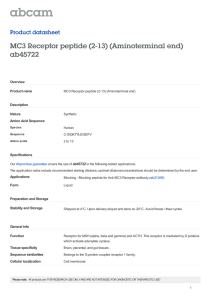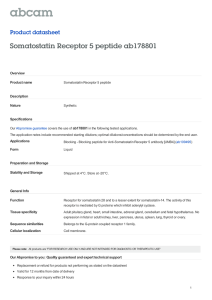Harvard-MIT Division of Health Sciences and Technology

Harvard-MIT Division of Health Sciences and Technology
HST.021: Musculoskeletal Pathophysiology, IAP 2006
Course Director: Dr. Dwight R. Robinson
Final Examination
HST.02
1
February 2, 2001
Name________________________
1. Define Wolff’s Law and give three examples of its application.
2A. Explain the differences between lamellar bone and woven bone regarding: a.
cellularity b.
arrangement of collagen c.
cellular polymorphism
B. Why is it important to know the differences? (give three examples)
3. Discuss the differences between osteoblasts and osteoclasts regarding: a. origin of cell (lineage) b. function c. hormonal control - cell surface receptors d. cell organelles e. example of disorder where each cell does not function
4. Briefly describe the vascular supply to a long tubular bone. How are the cortex and trabecular bone nourished?
5. Define: a. epiphysis b. metaphysic c. diaphysis d. primary center of ossification e. primary trabecula or spongiosum
(Circle the correct answers)
6. Infections agents are well documented to cause:
Systemic lupus erythematosis
Psuedogout
Cross out the incorrect words or phrases (in parenthesis) in questions 7-10.
7. The earliest pathologic change in osteoarthritis is the loss of (proteoglycan, collagen) from the (superficial, deep) layers of articular cartilage. There is (major, minor) infiltration of inflammatory cells in the synovium. Clefts in articular cartilage lead to pain from (stimulation of neurons in the cartilage, other mecahanisms). Osteophytes are
(growths, erosions) from the lateral margins of the joint.
8. The limited so9lubility of (uric acid, monosodium urate, disodium urate) is responsible for acute gouty arthritis. Sodium urate crystals in the synovium may be removed by treatment of patients with (alkali, a uricosuric agent, a xanthine oxidase inhibitor, a weight reducing diet). Gout is common in patients who are (vegetarians, obese, alcoholics, being treated for leukemia with chemotherapy, patients with renal failure, patients with deficiency of hypoxanthine-guanine phosphoribosyltransferase, patients with deficiencies of PRPP synthetase.)
9. Growth of long bones is largely determined by the growth plate on the side derived from the (primary center of ossification, secondary center of ossification). Regulation of growth involves several molecular signals. The growth of the zone of proliferating cartilage is (stimulated, retarded, induced to mature to the hypertrophic stage) by signaling through the PTHrP receptor. The activity of the PTHrP is (opposed, stimulated) by Indian hedge hog (IHH) through its receptor, patched/smoothened, which is expressed in the (chondrocytes, perchondrium). The activation of patched/smoothened stimulates the formation of (PTH, PTHrP, 1,25-dihydroxyvitamin D).
Activation of the PTHrP receptor acts as a (break, stimulant) for maturation of chondrocytes into the hypertrophic phase. The effects of PTHrP receptor activation are
(opposed, synergistic with) IHH. IHH is produced in the prehypertrophic zone of proliferating chondrocytes where it (stimulates, retards) chondrocyte proliferation.
A rare human disorder causing dwarfism is caused by a constitutively active mutation of the (THFa receptor, IL-1 receptor, PTHrP receptor). This leads to
(overgrowth, underdevelopment) of the zone of proliferating chondrocytes at the growth plate, resulting in short stature and radiographs resembling (hypothyroidism, rickets, osteoporosis). This genetic disorder has implications for mineral metabolism. A constitutively active mutation of the PTHrP receptor is associated with (increased, decreases, normal) serum calcium, (increased, decreased, normal) serum phosphorus, and
(increased, decreased, or normal) levels of serum PTH.
Other hereditary forms of dwarfism results from (activating mutations of the
FGFR3 receptor, inactivating mutations of the PTHrP receptor, inactivation mutations of the FGFR3 receptor).
10. The loss of kidney function (uremia) often leads to hypocalcemia. Why? What would be the resulting metabolic bone disease, and how would you treat it?
11. What are the levels of serum and urine calcium and phosphorus and serum PTH in a patient with nutritional vitamin D deficiency?
12. What is the differential diagnosis of a 75 year old woman with a compression fracture of the body of the 7 th thoracic vertebra? What tests would you do to help arrive at a diagnosis?
13. What is the joint reactive force F j
during the single legged stance phase of gait for a female patient who weights 55 kg? Assume that the abductor force F
AB
from the gluteus medius is a single point force acting at the tip of the grater trochanter, and that the center of hip rotation is at the center of the femoral head. The acceleration of gravity is 9.8 m/s 2 .
Figure by MIT OCW.
14. Biomechanics helps us to understand the structure of our long bones. The diaphysis of long bones are composed of a cortical shell that provides structural support, while the center consists of a marrow core that is responsible for hematopoiesis. The stresses of the cortex can be characterized by the following beam bending equation:
σ =My/I
Where M= bending moment, y = distance from the neutral axis, and I = area moment of inertia. a) Where are the highest stresses under this bending moment? Draw the distribution of stresses for the cross section . b) Consider a long bone under bending and assume that the bone can be modeled as a hollow cylindrical tube. Calculate the stress at the tensile surface in terms of M assuming the inner radius r i
= 1.0 cm, and the outer radius r o
= 1.5 cm. c) Determine the change in stress assuming that r o
increases by 1 mm (such expansions in outer diameter can occur with aging). d) Assume that the strength of young bone is 120 MPa but decreases to 100 MPa at age 80 while r o
increases from 1.5 cm to 1.6 cm. Determine if the loss of strength is offset by the radial expansion when the bone is loaded by bending moment M.
( Hint : Compare the safety factor for the two states for a given M.)






